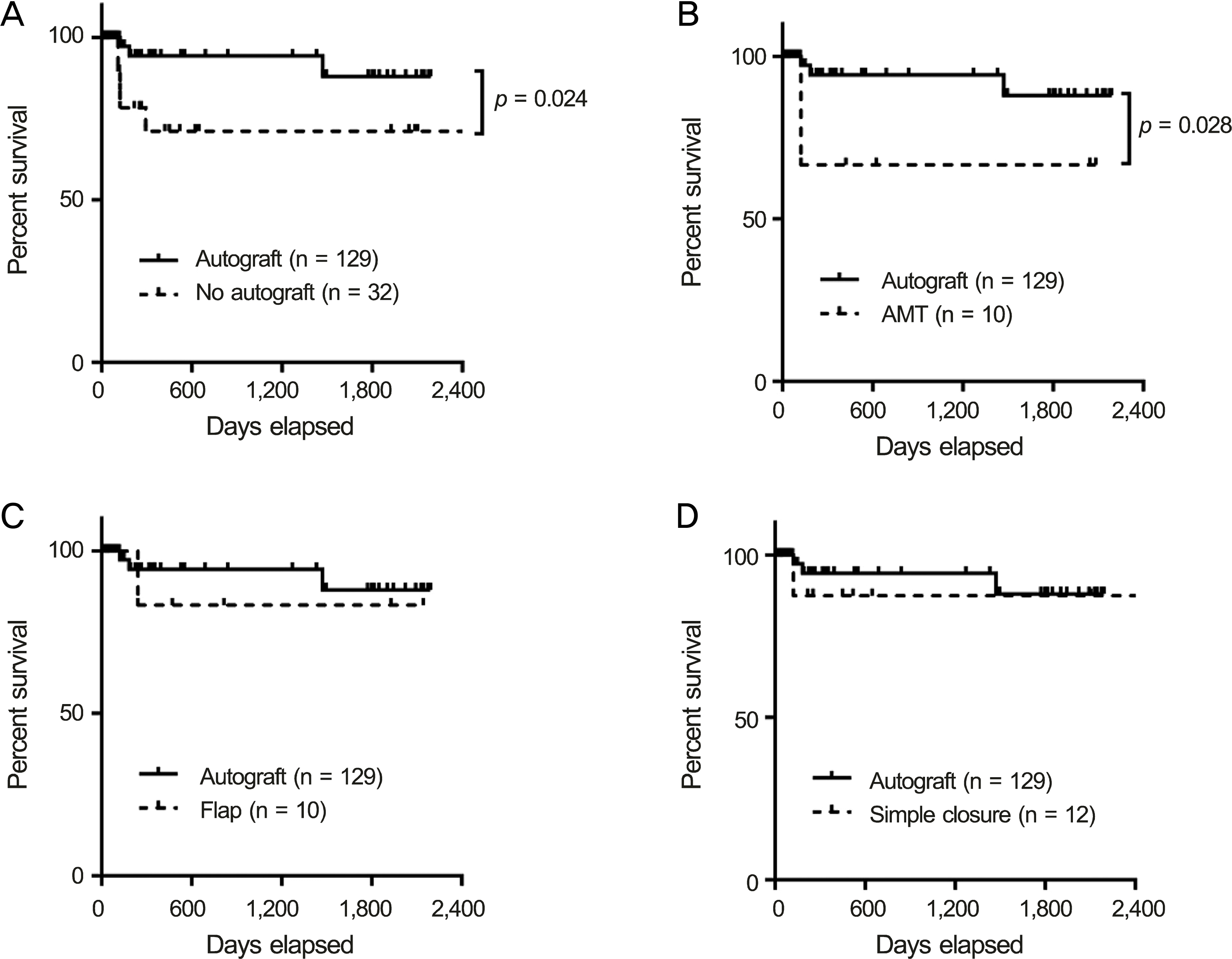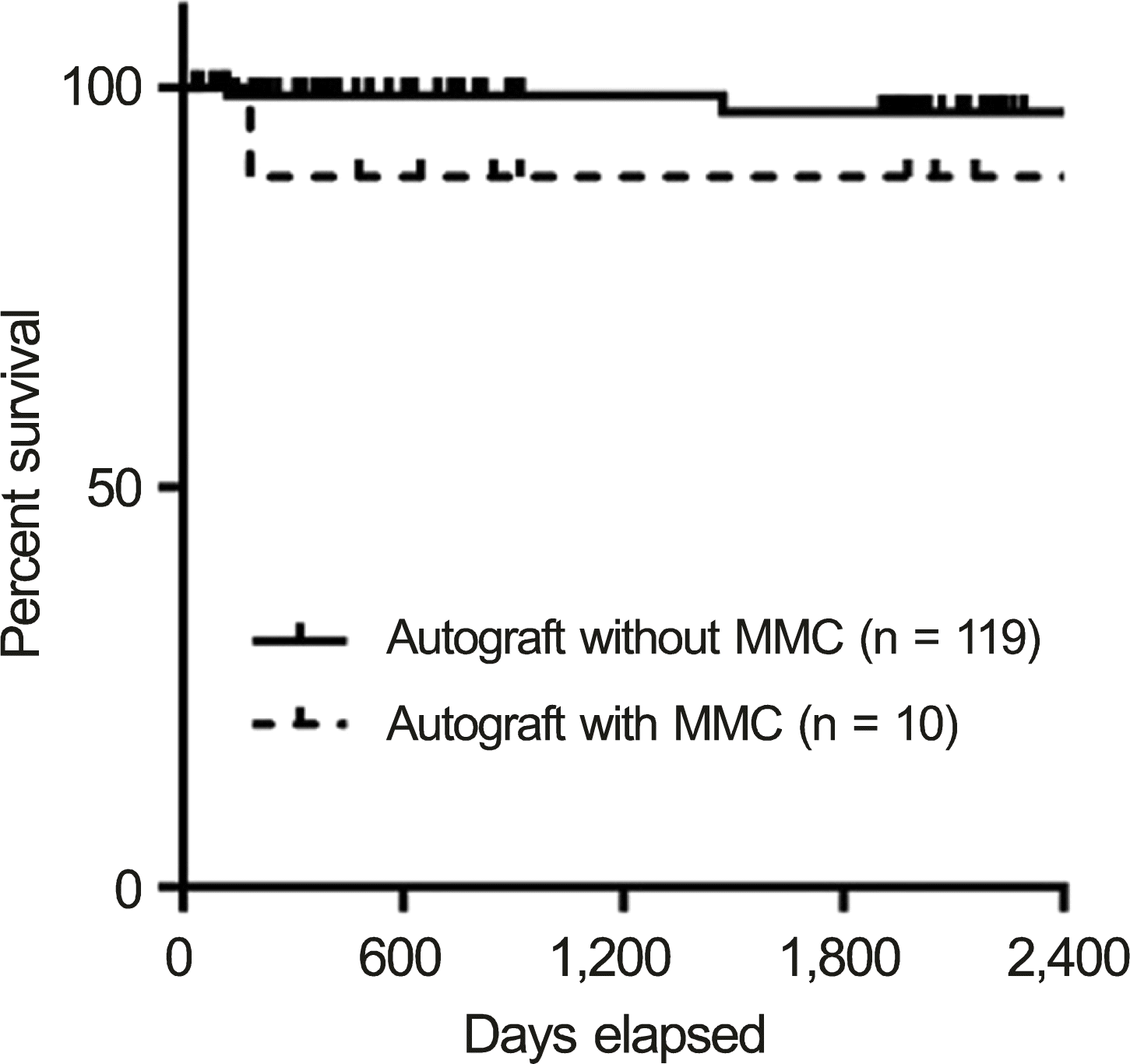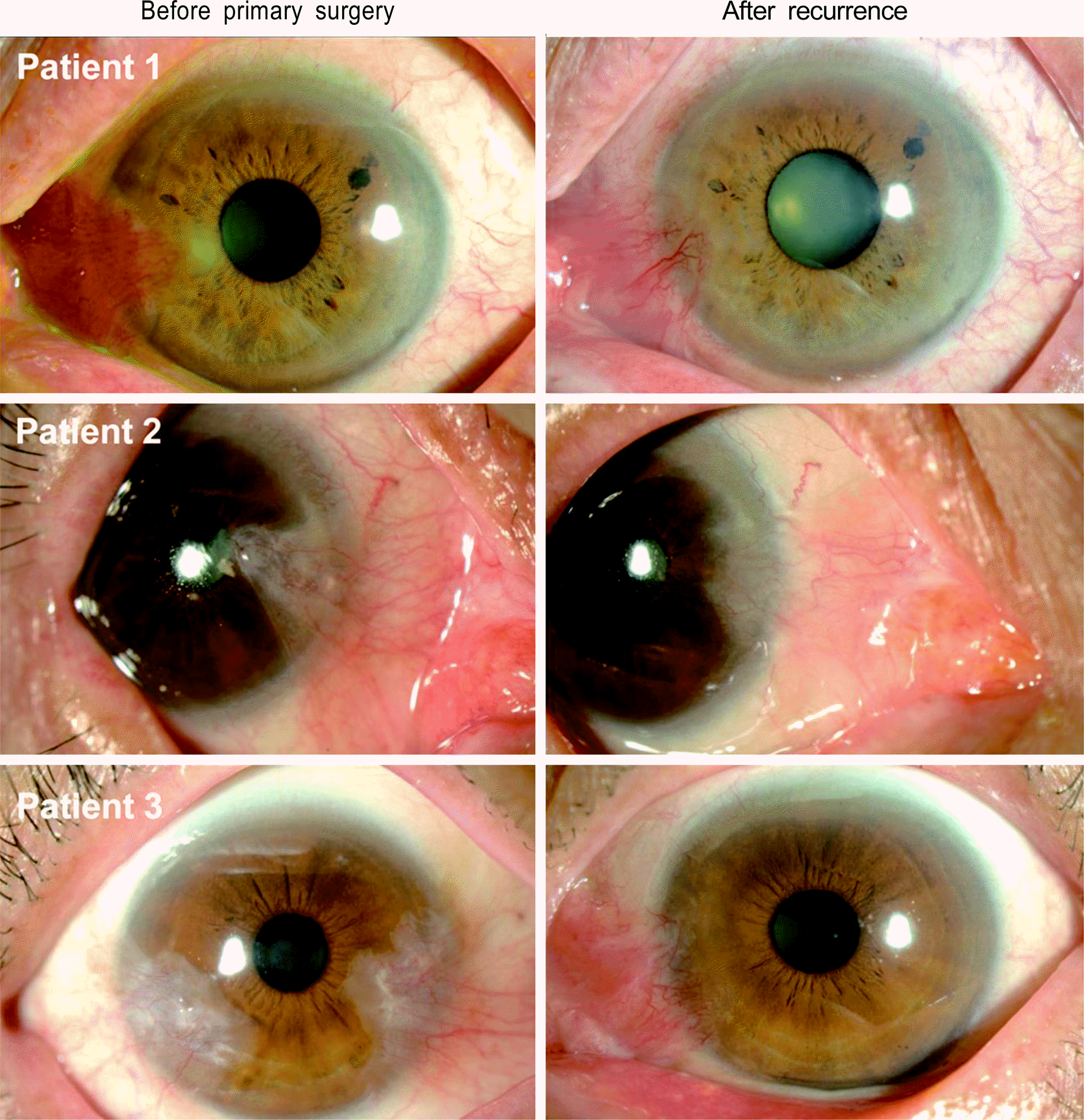Abstract
Purpose
To investigate the clinical outcomes of primary pterygium excision combined with free conjunctival autograft.
Methods
The medical records of 112 patients (129 eyes) who underwent pterygium excision and free conjunctival autograft for primary pterygium were retrospectively reviewed for recurrence and postoperative complications and the outcomes compared with pterygium excision combined with amniotic membrane transplantation, conjunctival flap, or simple conjunctival closure. Additionally, the surgical outcomes were evaluated in relation to the intraoperative use of mitomycin C.
Results
Postoperative recurrences were observed in 3 of 129 eyes (2.3%) that received pterygium excision and free conjunctival autograft, 2 of 10 eyes (20.0%) that received pterygium excision with amniotic membrane transplantation, 1 of 10 eyes (10.0%) that received pterygium excision with conjunctival flap and 1 of 12 eyes (8.3%) that received pterygium excision and simple conjunctival closure. Therefore, the recurrence rate was significantly lower in patients with conjunctival autograft than in those without (p = 0.024, Breslow-Wilcoxon test). Additionally, recurrence was observed in 1 of 10 eyes (10.0%) in patients that underwent pterygium surgery when mitomycin C was used intraoperatively and in 2 of 119 eyes (1.7%) without the use of mitomycin C.
Go to : 
References
1. Taylor HR, West S, Muñoz B, et al. The long-term effects of visible light on the eye. Arch Ophthalmol. 1992; 110:99–104.

2. Di Girolamo N, Chui J, Coroneo MT, Wakefield D. Pathogenesis of pterygia: role of cytokines, growth factors, and matrix meta- lloproteinases. Prog Retin Eye Res. 2004; 23:195–228.
3. Reisman D, McFadden JW, Lu G. Loss of heterozygosity and p53 expression in pterygium. Cancer Lett. 2004; 206:77–83.

4. Tan DT, Tang WY, Liu YP, et al. Apoptosis and apoptosis related gene expression in normal conjunctiva and pterygium. Br J Ophthalmol. 2000; 84:212–6.

5. Solomon A, Li DQ, Lee SB, Tseng SC. Regulation of collagenase, stromelysin, and urokinase-type plasminogen activator in primary pterygium body fibroblasts by inflammatory cytokines. Invest Ophthalmol Vis Sci. 2000; 41:2154–63.
6. Yoon KC, Mun GH, Kim SD, et al. Prevalence of eye diseases in South Korea: data from the Korea national health and nutrition examination survey 2008-2009. Korean J Ophthalmol. 2011; 25:421–33.

8. Kaufman SC, Jacobs DS, Lee WB, et al. Options and adjuvants in surgery for pterygium: a report by the American Academy of Ophthalmology. Ophthalmology. 2013; 120:201–8.
9. Ang LP, Chua JL, Tan DT. Current concepts and techniques in pterygium treatment. Curr Opin Ophthalmol. 2007; 18:308–13.

10. Young AL, Ho M, Jhanji V, Cheng LL. Ten-year results of a randomized controlled trial comparing 0.02% mitomycin C and limbal conjunctival autograft in pterygium surgery. Ophthalmology. 2013; 120:2390–5.

11. Kim CH, Lee JK, Park DJ. Recurrence rates of amniotic membrane transplantation, conjunctival autograft and conjunctivolimbal autograft in primary pterygium. J Korean Ophthalmol Soc. 2009; 50:1780–8.

12. Tan DT, Chee SP, Dear KB, Lim AS. Effect of pterygium morphol-ogy on pterygium recurrence in a controlled trial comparing conjunctival autografting with bare sclera excision. Arch Ophthalmol. 1997; 115:1235–40.

13. Gazzard G, Saw SM, Farook M, et al. Pterygium in Indonesia: prevalence, severity and risk factors. Br J Ophthalmol. 2002; 86:1341–6.

14. Durkin SR, Abhary S, Newland HS, et al. The prevalence, severity and risk factors for pterygium in central Myanmar: the Meiktila Eye Study. Br J Ophthalmol. 2008; 92:25–9.

15. Zheng K, Cai J, Jhanji V, Chen H. Comparison of pterygium recurrence rates after limbal conjunctival autograft transplantation and other techniques: meta-analysis. Cornea. 2012; 31:1422–7.
16. Jaworski CJ, Aryankalayil-John M, Campos MM, et al. Expression analysis of human pterygium shows a predominance of conjunctival and limbal markers and genes associated with cell migration. Mol Vis. 2009; 15:2421–34.
17. Reid TW, Dushku N. What a study of pterygia teaches us about the cornea? Molecular mechanisms of formation. Eye Contact Lens. 2010; 36:290–5.

18. Chui J, Coroneo MT, Tat LT, et al. Ophthalmic pterygium: a stem cell disorder with premalignant features. Am J Pathol. 2011; 178:817–27.
19. Danjo S, Friend J, Thoft RA. Conjunctival epithelium in healing of corneal epithelial wounds. Invest Ophthalmol Vis Sci. 1987; 28:1445–9.
21. Kareem AA, Farhood QK, Alhammami HA. The use of anti-metabolites as adjunctive therapy in the surgical treatment of pterygium. Clin Ophthalmol. 2012; 6:1849–54.
22. Shehadeh-Mashor R, Srinivasan S, Boimer C, et al. Management of recurrent pterygium with intraoperative mitomycin C and conjunctival autograft with fibrin glue. Am J Ophthalmol. 2011; 152:730–2.

23. Bae SG, Kim JK, Lee JK, Park DJ. The effectiveness of mitomycin C on pterygium surgery with amniotic membrane transplantation. J Korean Ophthalmol Soc. 2012; 53:200–7.

24. Kheirkhah A, Izadi A, Kiarudi MY, et al. Effects of mitomycin C on corneal endothelial cell counts in pterygium surgery: role of application location. Am J Ophthalmol. 2011; 151:488–93.

25. Menghini M, Watson SL, Bosch MM. Corneal melting two weeks after pterygium excision with topical mitomycin C: successfully treated with lamellar keratoplasty and amnion membrane transplantation. Case Rep Ophthalmol. 2012; 3:24–9.

26. Owoeye JF, Ayorinde OO. Surgically induced necrotising scleritis after pterygium excision. West Afr J Med. 2012; 31:142–4.
Go to : 
 | Figure 1.The Kaplan-Meier survival curves of pterygium recurrence after surgery. (A) Pterygium excision with conjunctival autograft vs. pterygium excision without conjunctival autograft. The recurrence rate of pterygium was significantly lower in conjunctival autograft group (p = 0.024, Breslow-Wilcoxon test). (B) Pterygium excision with conjunctival autograft vs. pterygium excision with amniotic membrane transplantation (AMT). The recurrence rate of pterygium was significantly lower in conjunctival autograft group, compared to amniotic membrane transplantation group (p = 0.028, Breslow-Wilcoxon test). (C) Pterygium excision with conjunctival autograft vs. pterygium excision with conjunctival flap. (D) Pterygium excision with conjunctival autograft vs. pterygium excision with simple conjunctival closure. There are no significant differences in the recurrence between conjunctival autograft group and conjunctival flap or simple closure group. |
 | Figure 2.The Kaplan-Meier survival curve of pterygium recurrence after pterygium excision with conjunctival autograft according to the intraoperative use of mitomycin C. One eye recurred in 10 eyes (10.0%) with pterygium surgery using mitomycin C intraoperatively, while two of 119 eyes (1.7%) without the use of mitomycin C recurred. The difference is not statistically significant. MMC = mitomycin C. |
 | Figure 3.Anterior segment photographs of patients that developed recurrence after primary pterygium excision with conjunctival autograft. The preoperative and postoperative photographs of three eyes whose pterygium recurred after pterygium excision with conjunctival autograft showed that recurred pterygia were milder in size, vascularization, and fleshiness, compared to those before excision. Patient 1 had recurrence at the postoperative 6 months, patient 2 at the postoperative 49 months, and patient 3 at the postoperative 4 months. |
Table 1.
Patient demographics and clinical characteristics
Table 2.
Comparison between conjunctival autografts with and without intraoperative mitomycin C




 PDF
PDF ePub
ePub Citation
Citation Print
Print


 XML Download
XML Download